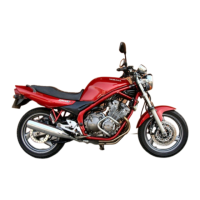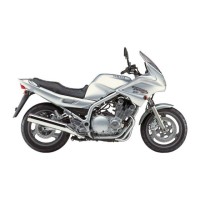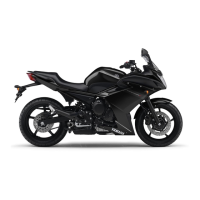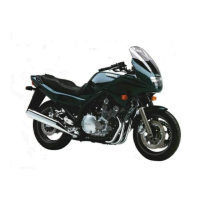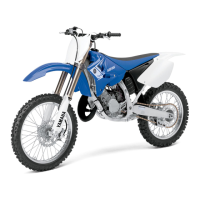
Do you have a question about the Yamaha diversion XJ6-S and is the answer not in the manual?
| Brand | Yamaha |
|---|---|
| Model | diversion XJ6-S |
| Category | Motorcycle |
| Language | English |
Read this manual carefully before operating this vehicle.
Declares product compliance with R&TTE Directive and other norms.
Welcome message and emphasis on reading the manual for safe operation.
Explanation of WARNING, NOTICE, and TIP symbols used in the manual.
Copyright and edition details for the XJ6SA Owner's Manual.
Owner's role in safe operation and essential safe riding practices.
Riding tips, passenger safety, and essential protective apparel.
Hazards of exhaust fumes and guidelines for loading cargo/accessories.
Risks of aftermarket parts and accessory placement effects on stability.
Procedures for safely transporting the motorcycle on another vehicle.
Identification of key components on the left side of the motorcycle.
Identification of key components on the right side of the motorcycle.
Identification of handlebar switches, levers, and the meter unit.
Explanation of the immobilizer system and key usage for theft prevention.
Details on the ON, OFF, LOCK, and Parking (P) positions of the main switch.
Step-by-step instructions for locking and unlocking the steering.
Description of the parking position and its limitations.
Meaning of turn signal, neutral, high beam, and other indicator lights.
Understanding coolant temperature readings and overheating warnings.
Function of engine trouble and ABS warning lights and troubleshooting.
Description of the speedometer, tachometer, odometer, and other displays.
Information on reading and using the tachometer for engine speed.
Setting the clock and navigating between odometer and trip meters.
How the fuel meter indicates fuel level and reserve.
Understanding the coolant temperature display and its indications.
Information on error codes and the self-diagnosis device.
Steps to resolve immobilizer system error codes.
Operation of pass, dimmer, turn signal, horn, and hazard switches.
Functions of engine stop, start, pass, dimmer, horn, and hazard switches.
How to operate the clutch lever for smooth operation.
Operation of the shift pedal and the front brake lever.
Correct procedure for applying the rear brake.
Explanation of ABS operation, self-diagnosis, and warnings.
Instructions for opening and closing the fuel tank cap securely.
Safety guidelines to follow during refueling to prevent fires and injury.
Pre-operation checks for fuel tank hoses and connections.
Warnings about hot exhaust systems and unleaded fuel requirements.
Step-by-step guide for removing and installing the motorcycle seat.
Instructions on how to secure a helmet using the helmet holder.
Location of the storage compartment and its load capacity.
Information on adjusting handlebar position for rider preference.
Procedure for folding mirrors for parking in narrow spaces.
How to adjust the shock absorber spring preload for suspension tuning.
Using the sidestand and safety warnings related to its function.
Explanation of how the ignition system is cut off by switches.
Step-by-step guide to check the operation of the ignition circuit cut-off system.
Key checks for fuel, engine oil, coolant, and front brake.
Checks for rear brake, clutch operation, and throttle grip.
Inspections for cables, drive chain condition, and tire pressure.
Checking chassis fasteners, lights, signals, switches, and sidestand switch.
Importance of understanding all controls before riding.
Conditions required and steps to start the engine safely.
How to shift gears and identify the neutral position.
Riding techniques to improve fuel economy.
Recommended procedures for the first 1600 km of engine operation.
Instructions for parking the motorcycle safely, avoiding hot surfaces and fire risks.
Benefits of periodic inspection, adjustment, and lubrication for safety.
Location and purpose of the owner's tool kit for maintenance.
Scheduled checks and maintenance for emission control components.
Maintenance checks for air filter, clutch, brakes, hoses, wheels, and tires.
Checks and lubrication for swingarm, steering bearings, and pivots.
Maintenance for front fork, shock absorber, engine oil, and cooling system.
Guidelines for replacing the disposable air filter element.
Brake fluid level checks and replacement intervals for seals and hoses.
Steps to remove and install Panel A.
Steps to remove and install Panels B and C.
Steps to remove and install Cowling A.
Steps to remove and install Cowlings B and C.
Importance of spark plug checks for engine condition and performance.
How to measure and adjust spark plug gap and proper tightening.
Procedure for checking the engine oil level before riding.
Detailed steps for changing the engine oil and oil filter cartridge.
Torque specifications and O-ring seating for oil filter installation.
Torque for drain bolt and recommended engine oil quantity.
How to check the coolant level in the reservoir and radiator.
Instructions for adding coolant to the reservoir and safety warnings.
Steps for draining, flushing, and refilling the cooling system.
Procedures for flushing the system with water and refilling with coolant.
Recommended antifreeze ratio and coolant quantities.
Checking coolant levels and for leaks after a coolant change.
Detailed instructions for removing and installing the air filter element.
Procedure and specifications for adjusting the engine's idling speed.
How to check and adjust the throttle grip's free play.
Importance of valve clearance checks and dealer adjustment.
Procedure for checking and adjusting tire air pressure for safety.
Checking tires for damage, wear, and tread depth.
Recommended tire air pressures for different loads and riding conditions.
Information on approved tires, valve caps, and tire aging.
Checking cast wheels for damage and the importance of balancing.
Procedure for adjusting clutch lever free play and its specifications.
How to check for free play in the brake lever and potential issues.
Ensuring the brake light activates correctly before braking.
How to check the wear on front brake pads using the indicator groove.
How to check the wear on rear brake pads using the indicator groove.
Procedure for checking brake fluid levels in reservoirs and required fluid type.
Warnings about brake fluid damaging surfaces and proper handling.
Recommended intervals for changing brake fluid and replacing seals/hoses.
How to measure the slack in the drive chain.
Procedure for adjusting drive chain slack and associated warnings.
Recommended method for cleaning the drive chain with kerosene.
Using special O-ring chain lubricant and warnings against other oils.
Ensuring smooth operation of control cables and lubricating them.
Checking throttle grip operation and lubricating the cable.
Checking pedal operation and lubricating pivots.
Checking lever operation and lubricating pivots.
Checking stand operation and lubricating pivots.
Swingarm pivot lubrication by a Yamaha dealer at specified intervals.
Inspecting inner tubes for damage and checking fork operation.
Checking steering bearings for looseness or wear.
Checking wheel bearings for play and smooth rotation.
Battery type, safety warnings, and checking lead connections.
Guidelines for charging and storing the battery, especially for long periods.
Location of fuses and the procedure for replacing them.
List of fuses and their specified amperage ratings.
Steps for replacing a blown fuse safely and correctly.
Detailed steps and precautions for replacing a burnt-out headlight bulb.
Steps for replacing the tail and brake light bulb.
Steps for replacing a burnt-out turn signal light bulb.
Steps for replacing the license plate light bulb.
What to do if the auxiliary light does not illuminate.
Overview of troubleshooting procedures for common issues.
Diagnosing starting problems related to the fuel system.
Diagnosing starting problems related to the battery.
Diagnosing starting problems related to the ignition system.
Diagnosing starting problems related to engine compression.
Steps to take if the engine overheats, including coolant checks.
Advice on cleaning and protecting matte colored parts.
Importance of regular cleaning for appearance and longevity.
Using water, mild detergent, and avoiding harsh chemicals on parts.
Safe methods for cleaning the windshield without scratching.
Steps after cleaning: drying, chain care, polishing, and protection spray.
Alerts about contaminants on brakes or tires causing loss of control.
Tips for storing the motorcycle in a cool, dry place for short periods.
Detailed steps for preparing the motorcycle for long-term storage.
Recommendation to complete any necessary repairs before storing the motorcycle.
Details on overall dimensions, engine type, displacement, and oil.
Specifications for fuel, clutch type, and transmission ratios.
Information on frame type, tire sizes, wheel types, and rim sizes.
Details on brake types, fluid, suspension travel, and caster angle.
Details on charging system, battery, headlight, and indicator lights.
List of fuses, their locations, and amperage ratings.
Location and importance of the VIN for identification and registration.
Location and importance of the model label for parts ordering.
